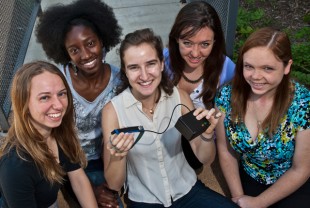Rice University students build sensor to save premature infants
Rice University students have developed an inexpensive, battery-powered neonatal monitor for infants that could save many lives in the developing world.
Five bioengineering students created the Babalung Apnea Monitor for a yearlong senior capstone project that is required of all graduating engineering students at Rice. The device consists of a small electronic microcontroller connected to an adjustable strap with a stretch sensor.
Team Breath Alert – Rachel Alexander, Rachel Gilbert, Jordan Schermerhorn, Bridget Ugoh and Andrea Ulrich – began with the knowledge that nearly half of the 12 million babies born prematurely in developing countries experience episodes of apnea, a sudden stoppage of breathing. In general, a tap on the foot can prompt the child to resume breathing, but the widespread occurrence of the problem means there isn’t always someone available to administer that simple remedy.
The Babalung may be the next best thing, an ingenious combination of low- and high-tech that tries on its own to restart a baby’s breathing and raises a flag if it can’t, the students said.
The first line of defense is the elastic sensor contained within the strap surrounding the infant’s chest. “The strap expands and contracts, which the system sees as a sine wave,” said Ulrich. When the wave stops for 20 seconds, the attached microcontroller turns on a vibrating motor to prompt the infant to take a breath. If the child still isn’t breathing five seconds later, a visual alarm is triggered.

A team of students has engineered the Babalung, a monitor that prompts premature infants who suffer from apnea to start breathing again and gives a visual alarm if they don't. From left: Andrea Ulrich, Bridget Ugoh, Rachel Gilbert, Jordan Schermerhorn and Rachel Alexander. Photo by Jeff Fitlow
“We thought about an audio alarm, but there’s the risk that a nurse wouldn’t hear it in a large room. And an alarm loud enough to hear might damage the baby’s hearing,” Alexander said.
“So we went with a flashing bike light raised above the crib, so you can see it across a room,” Gilbert said. “Now we’re doing research into what frequencies of pulsation attract the most attention.”
“This team has worked tirelessly to design a useful technology for very-low-resource settings,” said Maria Oden, director of Rice’s Oshman Engineering Design Kitchen and an adviser to the team. “They sought feedback from physicians who work in those settings and incorporated this advice into their prototype. The unique feature of the device is the system that alerts a baby as an intervention to apnea — all without requiring a nurse to intervene.”
Gary Woods, a Rice professor in the practice of computer technology in the department of electrical and computer engineering, is also advising the team. Woods’ own students have designed a smartphone app to receive data from the device via Bluetooth.
The team hopes to send three prototypes for testing in developing nations through Beyond Traditional Borders, part of the Rice 360˚: Institute for Global Health Technologies, this summer. But they envision uses for parents closer to home as well. While their primary goal is saving babies in developing countries, they would love to see Babalung on American shelves to give parents peace of mind.
“We did a survey in January, asking recent mothers whether or not they use a SIDS monitor or an apnea monitor for their infants, and if they did, what their biggest complaint was. The No. 1 complaint was the number of false alarms,” Alexander said.
In 50 tests that the students performed mostly on themselves, the Babalung gave no false alarms. “We caught every actual case of apnea,” Gilbert said. “We also learned how hard it is to stop breathing for 20 seconds.”
Team members said the device costs about $25 to build now, but they hope that continued development will drive the price down further for units bound to aid global health. “In developing nations, caregivers are so understaffed and overwhelmed that to provide something this simple feels like a straightforward solution,” Ugoh said.
Her incentive to join the project came from a place closer to her heart, though. “My sister had a baby last year, and she would stay up, not go to sleep, because she was worried whether her son was breathing or not,” Ugoh said. “I told her, ‘You know what? Next year I’m going to make you a device that detects breathing and will let you know.’ Lo and behold, this project was offered and it was on the top of my list.”


Andrea, we’re very proud! Great job by you and your team.
Love,
Dad & Mom
As a new mother, I worry constantly about the risk of SIDS. The Babalung would have made me more at ease. I can’t wait until it’s on the market and can help other new mothers rest easier at night. Thank you for your remarkable work and congratulations.
Congratulations on a tough job magnificently done! The idea seems simple and the execution elegant, hallmarks of a wonderful invention.
Jennifer Davidow
Brown ’97
Jordan, We’re so proud of you and your team for developing the Babalung. I know it will be instrumental in saving many infants.
We Love You,
Grandma & Grandpa Schermerhorn
Jordan, so very proud of you! You may not know this story, but I lost a little sister who died from SIDS. Amazing that you and your team have come up with such an amazing solution. Have a wonderful time in Africa.
Much love, Aunt Patti